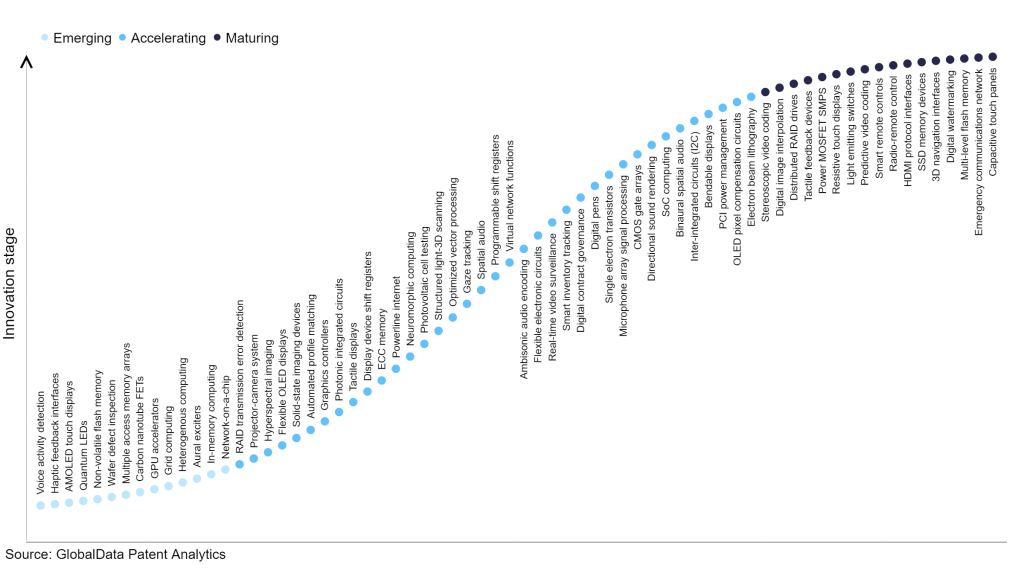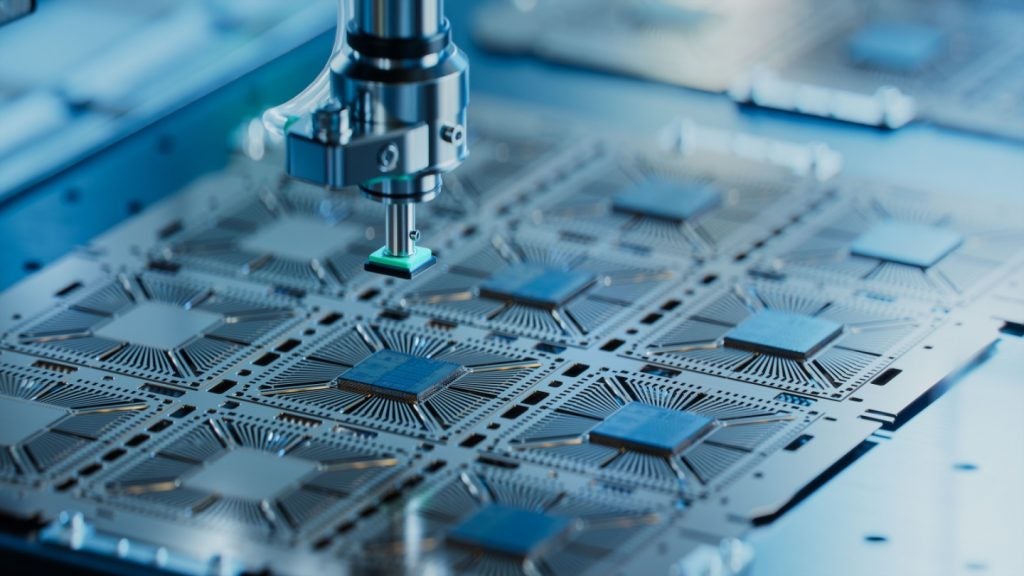The technology industry continues to be a hotbed of patent innovation. Activity is driven by the increasing demand for high-performance computing tasks in fields like scientific simulations, artificial intelligence, and data analytics, and growing importance of technologies such as advanced processor architectures, specialized vector instruction sets, and compiler optimizations, enabling faster and more energy-efficient execution of complex mathematical operations, leading to substantial improvements in computational efficiency and application performance. In the last three years alone, there have been over 4.1 million patents filed and granted in the technology industry, according to GlobalData’s report on Innovation in technology: optimized vector processing. Buy the report here.
However, not all innovations are equal and nor do they follow a constant upward trend. Instead, their evolution takes the form of an S-shaped curve that reflects their typical lifecycle from early emergence to accelerating adoption, before finally stabilizing and reaching maturity.
Identifying where a particular innovation is on this journey, especially those that are in the emerging and accelerating stages, is essential for understanding their current level of adoption and the likely future trajectory and impact they will have.
190+ innovations will shape the technology industry
According to GlobalData’s Technology Foresights, which plots the S-curve for the technology industry using innovation intensity models built on over 1.5 million patents, there are 190+ innovation areas that will shape the future of the industry.
Within the emerging innovation stage, network-on-a-chip, in-memory computing, and aural exciters are disruptive technologies that are in the early stages of application and should be tracked closely. Electron beam lithography, OLED pixel compensation circuits, and PCI power management are some of the accelerating innovation areas, where adoption has been steadily increasing. Among maturing innovation areas are capacitive touch panels and emergency communications network, which are now well established in the industry.
Innovation S-curve for the technology industry

Optimized vector processing is a key innovation area in technology
Optimized vector processing encompasses the streamlined execution of vector-based instructions within computer systems. This involves employing methods and circuits to refine the handling of vectorized data, leading to benefits like heightened speed, diminished power consumption, and overall enhanced performance.
GlobalData’s analysis also uncovers the companies at the forefront of each innovation area and assesses the potential reach and impact of their patenting activity across different applications and geographies. According to GlobalData, there are 100+ companies, spanning technology vendors, established technology companies, and up-and-coming start-ups engaged in the development and application of optimized vector processing.
Key players in optimized vector processing – a disruptive innovation in the technology industry
‘Application diversity’ measures the number of applications identified for each patent. It broadly splits companies into either ‘niche’ or ‘diversified’ innovators.
‘Geographic reach’ refers to the number of countries each patent is registered in. It reflects the breadth of geographic application intended, ranging from ‘global’ to ‘local’.
Patent volumes related to optimized vector processing
| Company | Total patents (2010 - 2022) | Premium intelligence on the world's largest companies |
| Desktone | 36 | Unlock Company Profile |
| Mobileye Vision Technologies | 6 | Unlock Company Profile |
| Samsung Electronics | 20 | Unlock Company Profile |
| ARM | 255 | Unlock Company Profile |
| Cambridge Consultants | 6 | Unlock Company Profile |
| Morgan Stanley Senior Funding | 9 | Unlock Company Profile |
| Marvell Asia | 7 | Unlock Company Profile |
| Fujitsu | 9 | Unlock Company Profile |
| Huawei Technologies | 4 | Unlock Company Profile |
| Turbonomic | 3 | Unlock Company Profile |
| 6 | Unlock Company Profile | |
| Hewlett Packard Enterprise Development | 5 | Unlock Company Profile |
| Apical | 3 | Unlock Company Profile |
| Imagination Technologies | 7 | Unlock Company Profile |
| NVIDIA Technology UK | 4 | Unlock Company Profile |
| Icera | 5 | Unlock Company Profile |
| Micron Technology | 9 | Unlock Company Profile |
| Qualcomm | 5 | Unlock Company Profile |
| Texas Instruments | 138 | Unlock Company Profile |
| Apple | 4 | Unlock Company Profile |
| NXP Semiconductors | 11 | Unlock Company Profile |
| Renesas Electronics | 3 | Unlock Company Profile |
| Koninklijke Philips | 2 | Unlock Company Profile |
| Advanced Micro Devices | 2 | Unlock Company Profile |
| Panasonic | 3 | Unlock Company Profile |
| Silicon Hive | 3 | Unlock Company Profile |
| Lynx Software Technologies | 16 | Unlock Company Profile |
| VMware | 38 | Unlock Company Profile |
| NVIDIA | 11 | Unlock Company Profile |
| IBM | 109 | Unlock Company Profile |
| STMicroelectronics | 7 | Unlock Company Profile |
| u-blox | 2 | Unlock Company Profile |
| NEC | 3 | Unlock Company Profile |
| Intel | 595 | Unlock Company Profile |
| Bracket Computing | 10 | Unlock Company Profile |
| Global Foundries | 2 | Unlock Company Profile |
| Swarm64 | 6 | Unlock Company Profile |
| Tigera | 4 | Unlock Company Profile |
| Guangdong Oppo Mobile Telecommunications | 4 | Unlock Company Profile |
| MicroUnity Systems Engineering | 22 | Unlock Company Profile |
| Andes Technology | 4 | Unlock Company Profile |
| Cambricon Technologies | 17 | Unlock Company Profile |
| Atlazo | 4 | Unlock Company Profile |
| Cerebras Systems | 3 | Unlock Company Profile |
| Blu Wireless Technology | 9 | Unlock Company Profile |
| Ab Initio Software | 3 | Unlock Company Profile |
| Shanghai Cambricon Information Technology | 10 | Unlock Company Profile |
| Scientia Sol Mentis | 2 | Unlock Company Profile |
| VeriSilicon Microelectronics (Shanghai) | 2 | Unlock Company Profile |
| Bright Data | 63 | Unlock Company Profile |
Source: GlobalData Patent Analytics
Among the companies innovating in optimized vector processing, Intel is one of the leading patents filers. The company’s patent describes a specific embodiment, a processor consisting of an instruction decoder responsible for interpreting a key instruction for gathering data elements from memory. This instruction includes a first parameter designating an initial storage location and a second parameter indicating a memory address holding multiple data elements. Furthermore, the processor integrates an execution unit connected to the instruction decoder. Upon receiving the initial instruction, the execution unit extracts contiguous first and second data elements from a memory location based on the memory address specified in the second parameter. Subsequently, it places the first data element in the initial entry of the first storage location, and the second data element in the secondary entry of a distinct storage location corresponding to the initial entry of the first storage location. Other prominent patent filers in the space include ARM and Texas Instruments.
In terms of application diversity, Bright Data leads the pack, while Marvell Asia and Tigera stood in second and third positions, respectively. By means of geographic reach, Bright Data held the top position, followed by Intel and Bracket Computing.
Optimized vector processing is instrumental in enhancing the computational efficiency of systems by enabling them to efficiently handle large datasets through specialized instructions. This technology significantly accelerates tasks like scientific simulations, multimedia processing, and data analytics, leading to faster and more powerful computing capabilities.
To further understand the key themes and technologies disrupting the technology industry, access GlobalData’s latest thematic research report on Technology.
Premium Insights
From

The gold standard of business intelligence.
Blending expert knowledge with cutting-edge technology, GlobalData’s unrivalled proprietary data will enable you to decode what’s happening in your market. You can make better informed decisions and gain a future-proof advantage over your competitors.




